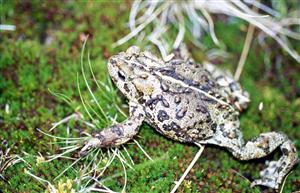The boreal toad is Colorado’s only alpine toad species, living in mountain lakes, ponds, meadows, and wetlands at elevations between 8,000 and 12,000 feet. Boreal toads eat a range of invertebrates and insects, including mosquitos, flies, moths, and beetles. They have warty skin with coloration ranging from brown to green, with a thin white stripe running down their backs. Female boreal toads grow to a little over 4 inches long and are typically larger than males, which grow to about 3.5 inches long. Unlike some louder toad species in Colorado, boreal toads make soft chirping sounds.

Despite the boreal toad’s resilience in living at high altitude, the species has faced a significant decline in population. Colorado Parks and Wildlife (CPW) listed the boreal toad as a state endangered species in 1993 and has undertaken an effort to research and reintroduce the boreal toad into its natural habitat.
The challenge
Over the past few decades, the boreal toad population in Colorado has experienced a dramatic decline. Like other amphibians, boreal toads use their skin to absorb oxygen, so they are more sensitive to harm from water contaminants and changes in water level and temperature. Factors such as habitat loss, climate change, pollution, and the spread of the chytrid fungus have contributed to their diminishing numbers.
The chytrid fungus is a primary reason for the boreal toad’s sudden decline. This fungus causes chytridiomycosis, an infectious disease that affects many amphibians and is particularly deadly in boreal toads. The chytrid fungus is found throughout the boreal toad’s native habitat in Colorado.
Boreal toad research
Recognizing the urgency to address this ecological crisis, CPW initiated research programs to understand the boreal toad’s decline and develop effective strategies for its survival. Many of these research reports are available in our digital repository:
- Boreal toad research progress report (1995 – 2010)
- Report on the status and conservation of the Boreal toad, Bufo boreas boreas, in the southern Rocky Mountains (2001 – 2007)
- Boreal toad research report (2003)
- Surveys for Boreal Toads (Bufo boreas boreas) in and near the Northern Portion of the Powderhorn Wilderness, Gunnison and Hinsdale Counties, Colorado: Summer 2002
- Boreal toad husbandry manual (2002)
Through their research, CPW scientists have gained valuable insights into the toad’s habitat requirements and the impacts of various stressors on their survival. Prepared with this knowledge, CPW has embarked on a reintroduction program aiming to restore healthy boreal toad populations to their native ranges.
Reintroduction efforts
Reintroduction of boreal toads involves collecting eggs and raising tadpoles in CPW’s fish hatcheries and at the Native Aquatic Species Restoration Facility. Late-stage tadpoles (tadpoles that have started to grow legs) are released either into native boreal toad habitats or into ponds built specifically for boreal toad reintroduction. CPW closely monitors these reintroduced populations, tracking their progress and assessing the success of the program.
CPW produced two videos documenting their boreal toad reintroduction efforts. The first, Southwest native aquatic species, 2018-2019 boreal toad conservation efforts (2019) describes the effort to reestablish boreal toad populations in southwestern Colorado, including building new ponds to serve as boreal toad habitat. The second, Saving Colorado’s boreal toads (2020) describes a successful reintroduction project at Zimmerman Lake in northern Colorado.
Most recently, CPW partnered with the Denver Zoo to raise and release 570 tadpoles into high-altitude wetlands in the Gunnison National Forest.
A Glimpse of Hope
While the journey to restore the boreal toad population is challenging, the efforts of CPW experts have yielded encouraging results. Through their research and reintroduction initiatives, the organization has managed to establish self-sustaining populations in certain areas. This success not only benefits the boreal toads but also contributes to the overall health and diversity of the ecosystems they inhabit.
Stay up-to-date on the boreal toad’s introduction effort by following CPW’s news releases.
- Colorado State Parks: Paonia - April 19, 2024
- Understanding Colorado’s school district cost of living studies - April 5, 2024
- Colorado’s Governors: Clarence J. Morley - March 22, 2024